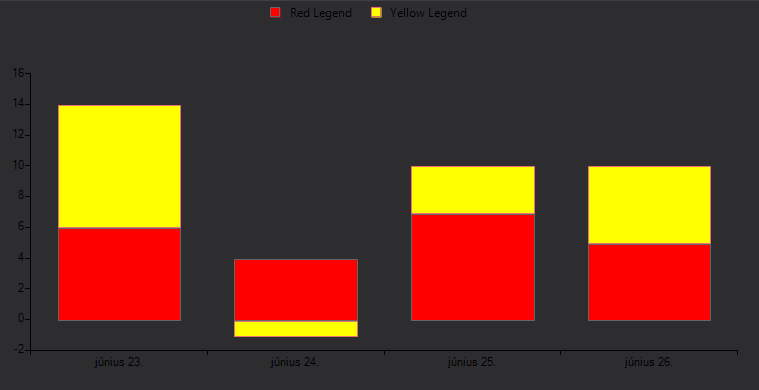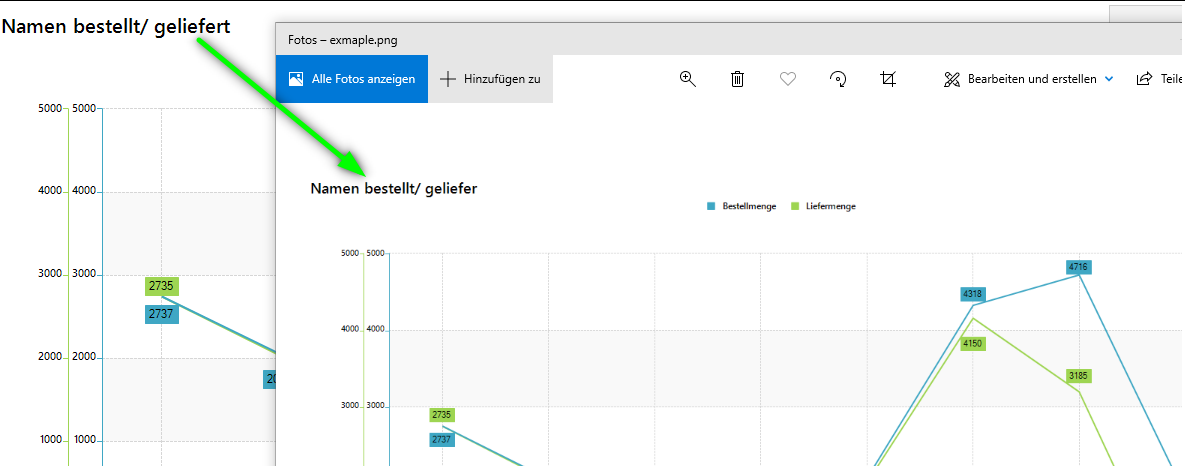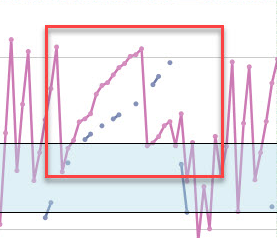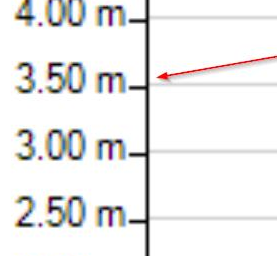Legend Item Text is not visible in Windows11Dark. This is because the LegendItem A possible workaround is to subscribe to the VisualItemCreating event. In the event handler, we can create a new LegendItemElement and set its ForeColor.
private void LegendElement_VisualItemCreating(object sender, LegendItemElementCreatingEventArgs e)
{
e.ItemElement = new LegendItemElement(e.LegendItem) { ForeColor = Color.Black };
}
Currently, VisualStudio2012DarkTheme has a white background in order to be able to read the labels. This change was done when addressing this item:
However, it is inconsistent a dark theme to have a white background color. The design should be improved to achieve consistent look and feel.
Before zoom:
After zoom:
Please refer to the attached sample project. Try to select a point.
Expected result: the clicked point should be colored in red.
Actual result: a random point is colored in red even though the label is colored correctly. The attached gif file illustrates the observed result.

System.OverflowException: 'Value was either too large or too small for a Decimal.
To reproduce:
var lineSeries = new LineSeries();
lineSeries.DataPoints.Add(new CategoricalDataPoint(0, "A"));
lineSeries.DataPoints.Add(new CategoricalDataPoint(Convert.ToDouble(decimal.MaxValue), "B"));
lineSeries.DataPoints.Add(new CategoricalDataPoint(0, "C"));
lineSeries.DataPoints.Add(new CategoricalDataPoint(decimal.ToDouble(decimal.MaxValue), "D"));
lineSeries.DataPoints.Add(new CategoricalDataPoint(0, "E"));
this.radChartView1.Series.Add(lineSeries);

radChartView1.AreaType = ChartAreaType.Cartesian;
var scatterSeries = new ScatterSeries();
scatterSeries.DataPoints.Add(new ScatterDataPoint(15, 19));
scatterSeries.DataPoints.Add(new ScatterDataPoint(18, 10));
scatterSeries.DataPoints.Add(new ScatterDataPoint(13, 15));
scatterSeries.DataPoints.Add(new ScatterDataPoint(10, 8));
scatterSeries.DataPoints.Add(new ScatterDataPoint(5, 12));
radChartView1.Series.Add(scatterSeries);
var verticalAxis = radChartView1.Axes.Get<LinearAxis>(1);
verticalAxis.Minimum = 0.0d;
verticalAxis.Maximum = 5.0d;
verticalAxis.MajorStep = 0.5d;
verticalAxis.LabelFormat = "{0:0.00} m";
for (var i = verticalAxis.Minimum; i <= verticalAxis.Maximum; i += verticalAxis.MajorStep)
{
var annotation1 = new CartesianGridLineAnnotation();
annotation1.Axis = this.radChartView1.Axes[1] as CartesianAxis;
annotation1.BorderColor = Color.LightGray;
annotation1.BorderDashStyle = DashStyle.Solid;
annotation1.BorderWidth = 1;
annotation1.Value = i;
radChartView1.Annotations.Add(annotation1);
}Workaround:
public RadForm1()
{
InitializeComponent();
this.radChartView1.CreateRenderer += radChartView1_CreateRenderer;
InitChart();
}
private void radChartView1_CreateRenderer(object sender, ChartViewCreateRendererEventArgs e)
{
e.Renderer = new CustomRenderer(e.Area as CartesianArea);
}
public class CustomRenderer : CartesianRenderer
{
public CustomRenderer(CartesianArea area) : base(area)
{
}
protected override void InitializeAnnotations(AnnotationDrawMode drawMode)
{
for (int i = 0; i < this.Area.Annotations.Count; i++)
{
if (this.Area.Annotations[i] is CartesianGridLineAnnotation && this.Area.Annotations[i].DrawMode == drawMode)
{
this.DrawParts.Add(new CustomCartesianGridLineAnnotationDrawPart(this.Area.Annotations[i] as CartesianGridLineAnnotation, this));
}
}
}
}
public class CustomCartesianGridLineAnnotationDrawPart : CartesianGridLineAnnotationDrawPart
{
public CustomCartesianGridLineAnnotationDrawPart(CartesianGridLineAnnotation element, CartesianRenderer renderer) : base(element, renderer)
{
}
public override void Draw()
{
FieldInfo fi = typeof(CartesianGridLineAnnotation).GetField("model", BindingFlags.Instance | BindingFlags.NonPublic);
ChartAnnotationModel model = fi.GetValue(this.Element) as ChartAnnotationModel;
RectangleF rect = ChartRenderer.ToRectangleF(model.LayoutSlot);
rect.Offset(this.ViewportOffsetX, this.ViewportOffsetY);
rect.Offset(new PointF(0,1));
Graphics graphics = this.Renderer.Surface as Graphics;
RadGdiGraphics radGraphics = new RadGdiGraphics(graphics);
Rectangle clipRect = ChartRenderer.ToRectangle(this.Element.View.GetArea<CartesianArea>().AreaModel.PlotArea.LayoutSlot);
clipRect.Offset((int)this.ViewportOffsetX, (int)this.ViewportOffsetY);
graphics.SetClip(clipRect);
GraphicsPath path = new GraphicsPath();
path.AddLine(rect.Location, new PointF(rect.Right, rect.Bottom));
BorderPrimitiveImpl border = new BorderPrimitiveImpl(this.Element, null);
border.PaintBorder(radGraphics, null, path, rect);
rect.Size = graphics.MeasureString(this.Element.Label, this.Element.Font);
rect.Offset(this.Element.PositonOffset.Width + 1, this.Element.PositonOffset.Height + 1);
TextParams tp = new TextParams();
tp.font = this.Element.Font;
tp.foreColor = this.Element.ForeColor;
tp.paintingRectangle = new RectangleF(rect.X, rect.Y, rect.Height, rect.Width);
tp.text = this.Element.Label;
FillPrimitiveImpl fill = new FillPrimitiveImpl(this.Element, null);
fill.PaintFill(radGraphics, null, rect);
radGraphics.DrawString(tp, new SizeF(rect.Height, rect.Width));
}
}
Public Class RadForm2
Public Sub New()
InitializeComponent()
AddHandler Me.RadChartView1.CreateRenderer, AddressOf radChartView1_CreateRenderer
Me.RadChartView1.ShowSmartLabels = True
Me.RadChartView1.ShowPanZoom = True
Dim barSeries As New BarSeries()
Dim barSeries1 As New BarSeries()
Dim barSeries2 As New BarSeries()
Dim rand As New Random()
barSeries.DataPoints.Add(New CategoricalDataPoint(101, 0))
barSeries1.DataPoints.Add(New CategoricalDataPoint(101, 0))
barSeries2.DataPoints.Add(New CategoricalDataPoint(101, 0))
For i As Integer = 1 To 9
barSeries.DataPoints.Add(New CategoricalDataPoint(rand.[Next](100), i))
barSeries1.DataPoints.Add(New CategoricalDataPoint(rand.[Next](100), i))
barSeries2.DataPoints.Add(New CategoricalDataPoint(rand.[Next](100), i))
Next
barSeries.ShowLabels = True
barSeries.DrawLinesToLabels = True
barSeries1.ShowLabels = True
barSeries1.DrawLinesToLabels = True
barSeries2.ShowLabels = True
barSeries2.DrawLinesToLabels = True
Me.RadChartView1.Series.Add(barSeries)
Me.RadChartView1.Series.Add(barSeries1)
Me.RadChartView1.Series.Add(barSeries2)
End Sub
Private Sub radChartView1_CreateRenderer(sender As Object, e As ChartViewCreateRendererEventArgs)
'e.Renderer = New CustomCartesianRenderer(TryCast(e.Area, CartesianArea))
End Sub
End Class
Workaround: Create a custom renderer
Public Class CustomCartesianRenderer
Inherits CartesianRenderer
Public Sub New(area As CartesianArea)
MyBase.New(area)
End Sub
Protected Overrides Sub Initialize()
MyBase.Initialize()
For i As Integer = 0 To Me.DrawParts.Count - 1
Dim labelPart As BarLabelElementDrawPart = TryCast(Me.DrawParts(i), BarLabelElementDrawPart)
If labelPart IsNot Nothing Then
Me.DrawParts(i) = New CustomBarLabelElementDrawPart(DirectCast(labelPart.Element, BarSeries), Me)
End If
Next
End Sub
End Class
Public Class CustomBarLabelElementDrawPart
Inherits BarLabelElementDrawPart
Public Sub New(owner As ChartSeries, renderer As IChartRenderer)
MyBase.New(owner, renderer)
End Sub
Public Overrides Sub Draw()
Dim graphics As Graphics = TryCast(Me.Renderer.Surface, Graphics)
Dim cartesianSeries As CartesianSeries = TryCast(Me.Element, CartesianSeries)
If cartesianSeries IsNot Nothing Then
Dim area As CartesianArea = DirectCast(cartesianSeries.[GetType]().GetField("area", BindingFlags.Instance Or BindingFlags.NonPublic).GetValue(cartesianSeries), CartesianArea)
Dim clipRect As RectangleF = DirectCast(area.[GetType]().GetMethod("GetCartesianClipRect", BindingFlags.Instance Or BindingFlags.NonPublic).Invoke(area, New Object() {}), RectangleF)
graphics.SetClip(clipRect)
End If
MyBase.Draw()
graphics.ResetClip()
End Sub
Protected Overrides Function GetLineStart(label As LabelElement, point As DataPointElement, isSmartLabel As Boolean) As PointF
Dim lineStart As PointF = MyBase.GetLineStart(label, point, isSmartLabel)
Dim x As Single = CSng(TryCast(Me.Element.View, IChartView).PlotOriginX)
Dim y As Single = CSng(TryCast(Me.Element.View, IChartView).PlotOriginY)
lineStart.X += x
lineStart.Y += y
Return lineStart
End Function
Protected Overrides Function GetLineEnd(label As LabelElement, point As DataPointElement, isSmartLabel As Boolean) As PointF
Dim lineEnd As PointF = MyBase.GetLineEnd(label, point, isSmartLabel)
If Not isSmartLabel Then
Dim x As Single = CSng(TryCast(Me.Element.View, IChartView).PlotOriginX)
Dim y As Single = CSng(TryCast(Me.Element.View, IChartView).PlotOriginY)
lineEnd.X += x
lineEnd.Y += y
End If
Return lineEnd
End Function
End Class
Note: similar to the axis, the series should also have ClipLabels property which will control whether the labels will be clipped or not.
How to reproduce: zoom and pan along the chart
public Form1()
{
InitializeComponent();
this.radChartView1.CreateRenderer += radChartView1_CreateRenderer;
this.radChartView1.ShowPanZoom = true;
BarSeries barSeries = new BarSeries();
Random rand = new Random();
for (int i = 1; i < 10; i++)
{
barSeries.DataPoints.Add(new CategoricalDataPoint(rand.Next(100), i));
}
barSeries.ShowLabels = true;
this.radChartView1.Series.Add(barSeries);
}
Workaround:
public partial class Form1 : Form
{
public Form1()
{
InitializeComponent();
this.radChartView1.CreateRenderer += radChartView1_CreateRenderer;
this.radChartView1.ShowPanZoom = true;
BarSeries barSeries = new BarSeries();
Random rand = new Random();
for (int i = 1; i < 10; i++)
{
barSeries.DataPoints.Add(new CategoricalDataPoint(rand.Next(100), i));
}
barSeries.ShowLabels = true;
this.radChartView1.Series.Add(barSeries);
}
private void radChartView1_CreateRenderer(object sender, ChartViewCreateRendererEventArgs e)
{
e.Renderer = new CustomCartesianRenderer(e.Area as CartesianArea);
}
}
public class CustomCartesianRenderer : CartesianRenderer
{
public CustomCartesianRenderer(CartesianArea area)
: base(area)
{ }
protected override void Initialize()
{
base.Initialize();
for (int i = 0; i < this.DrawParts.Count; i++)
{
BarLabelElementDrawPart labelPart = this.DrawParts[i] as BarLabelElementDrawPart;
if (labelPart != null)
{
this.DrawParts[i] = new CustomLabelElementDrawPart((BarSeries)labelPart.Element, this);
}
}
}
}
public class CustomLabelElementDrawPart : BarLabelElementDrawPart
{
public CustomLabelElementDrawPart(ChartSeries owner, IChartRenderer renderer)
: base(owner, renderer)
{ }
public override void Draw()
{
Graphics graphics = this.Renderer.Surface as Graphics;
CartesianSeries cartesianSeries = this.Element as CartesianSeries;
if (cartesianSeries != null)
{
CartesianArea area = (CartesianArea)cartesianSeries.GetType().GetField("area", BindingFlags.Instance | BindingFlags.NonPublic).GetValue(cartesianSeries);
RectangleF clipRect = (RectangleF)area.GetType().GetMethod("GetCartesianClipRect", BindingFlags.Instance | BindingFlags.NonPublic).Invoke(area, new object[] { });//.GetCartesianClipRect();
graphics.SetClip(clipRect);
}
base.Draw();
graphics.ResetClip();
}
}
Currently, RadChartView offers exporting to a Bitmap in one of the following formats: https://docs.microsoft.com/en-us/dotnet/api/system.drawing.imaging.imageformat?view=netframework-4.8
It would be nice to have export functionality to a vector image.
Hi team,
We need a ChartView with multiple series and multiple Y-axis. The axis color of each Y-axis should be automatically painted according to the palette setting (thank you for the brilliant work - it's very intuitive). However, if clear the series and re-assign a new set of series, the border color of the first axis changes to black, regardless which palette is active. If the palette is set to a new one, the border color can be re-painted correctly. See screenshot as attached.
How to reproduce: Please refer to the attached project for a demo of reproduction. Click the first button to populate new random data. The border color of the first axis should change to black after clicking the button twice and more times. Clicking the second button will force the palette to change and the border color will become normal.
Thank you, team.
Best,
Yusi
When you have BarSeries and LineSeries in RadChartView the problem is that the DataPoint.Presenter is always BarSerries, never LineSeries.
To workaround, create custom renderer:
this.radChartView1.CreateRenderer += this.RadChartView1_CreateRenderer;
private void RadChartView1_CreateRenderer(object sender, ChartViewCreateRendererEventArgs e)
{
e.Renderer = new CustomCartesianRenderer(e.Area as CartesianArea);
}
public class CustomCartesianRenderer : CartesianRenderer
{
public CustomCartesianRenderer(CartesianArea area)
: base(area)
{ }
public override DataPoint HitTest(int x, int y)
{
for (int i = this.DrawParts.Count - 1; i >= 0; i--)
{
DataPoint dataPoint = this.DrawParts[i].HitTest(new Point(x, y));
if (dataPoint != null)
{
return dataPoint;
}
}
return base.HitTest(x, y);
}
}
Use attached to reproduce.
- Click at least 7 times.
Workaround: Crete new series instance each time.
Stack trace:
System.NullReferenceException occurred
HResult=-2147467261
Message=Object reference not set to an instance of an object.
Source=Telerik.WinControls.ChartView
StackTrace:
at Telerik.Charting.CombinedBarSeriesRoundLayoutStrategy.ApplyLayoutRoundingVertical(LayoutContext context) in c:\Work\Development\RadControls\RadChartView\Engine\Series\Combination\BarSeries\CombinedBarSeriesRoundLayoutStrategy.cs:line 206
InnerException:
Inside the constructor of a form create a pie series and populate it with data. Then add it to a RadChartView. You will notice that there are two legend items per data point.




